You’ll want the Garmin Forerunner 945 LTE for thorough GPS tracking and safety features, or the Apple Watch Series 10 for seamless cellular connectivity and health monitoring. The Samsung Galaxy Watch Ultra offers robust durability with excellent display visibility, while budget-conscious runners should consider the Galaxy Watch FE for flagship features at lower costs. These LTE watches provide emergency SOS capabilities, music streaming without your phone, and real-time location sharing. Understanding battery performance, carrier compatibility, and setup requirements will help you choose the perfect running companion.
What Makes LTE Connectivity Essential for Phone-Free Running
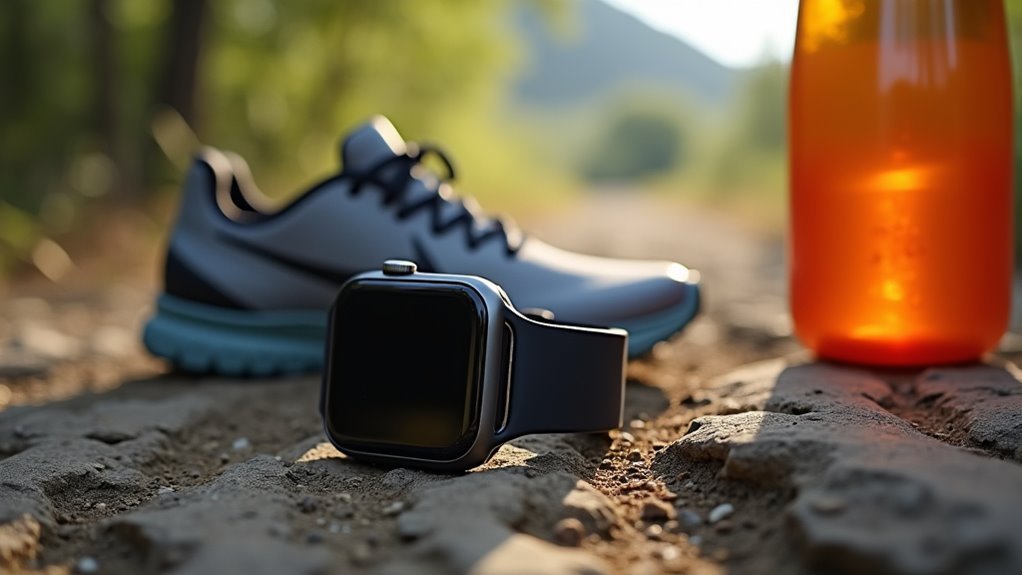
When you’re pounding the pavement without your phone, LTE connectivity transforms your smartwatch from a simple fitness tracker into a broad running companion.
You’ll access streaming music and podcasts directly from your wrist, eliminating the need to carry bulky devices. Emergency SOS features provide vital safety nets during solo runs, enabling immediate calls for help when needed.
LTE guarantees accurate GPS tracking for precise route mapping and navigation, while continuous heart rate monitoring keeps you informed about your fitness metrics.
You can interact with voice assistants hands-free, controlling music playlists and accessing real-time weather updates. This independent connectivity reduces distractions, letting you focus entirely on your run while maintaining essential communication capabilities and thorough fitness tracking.
For runners who qualify for assistance programs, some carriers offer free phone service through government programs that can help reduce monthly connectivity costs for your LTE-enabled devices.
Top 5 LTE Sports Watches That Replace Your Smartphone
You’ll find LTE sports watches that truly replace your smartphone fall into three distinct categories based on your priorities and budget.
Premium performance leaders offer cutting-edge features and robust connectivity, while battery life champions prioritize extended usage over multiple days of running. These watches typically require monthly carrier fees in addition to the initial purchase price.
Budget-friendly alternatives provide essential LTE functionality without the premium price tag, making phone-free running accessible to more athletes.
Premium Performance Leaders
For runners seeking total smartphone independence, these five premium LTE watches deliver professional-grade performance that eliminates the need to carry your phone.
| Watch Model | Key LTE Feature | Running Specialty |
|---|---|---|
| Garmin Forerunner 945 LTE | LiveTrack & Assistance Plus | Extensive GPS metrics |
| Apple Watch Series 10 | Untethered cellular use | ECG & health monitoring |
| Samsung Galaxy Watch Ultra | Robust connectivity | Large display visibility |
| Apple Watch Ultra 2 | Rugged cellular design | Extreme durability |
| Garmin Fenix 8 LTE | Advanced safety features | Professional navigation |
You’ll enjoy live tracking capabilities that let others monitor your route in real-time, plus emergency assistance features for solo runs. These watches offer offline music playback, continuous heart rate monitoring, and water resistance. While they’re pricier than non-cellular models, you’ll gain true independence with onboard maps and total notification management. The watches undergo extensive testing by health and fitness experts to ensure they meet professional standards for accuracy and performance.
Battery Life Champions
Endurance separates true running companions from fitness gadgets that die mid-workout. You need LTE watches that’ll power through your longest training sessions without tethering you to charging cables.
The Apple Watch Ultra 2 delivers 18 hours of LTE connectivity, handling calls and messages while tracking your runs.
Samsung’s Galaxy Watch Ultra pushes boundaries with two-day battery life, though LTE specifics aren’t detailed. The Galaxy Watch Ultra features dual-band GPS and efficient 3nm Exynos CPU technology that enhances performance without rapidly draining the battery.
Unfortunately, the longest-lasting options like Garmin’s Enduro 3 (180 hours GPS) and Amazfit’s T-Rex 3 (27 days standby) lack integrated LTE capabilities.
You’re facing a trade-off: maximum battery life or cellular independence. Current LTE technology demands more power, but Apple’s Ultra 2 strikes the best balance for runners wanting smartphone-free adventures.
Budget-Friendly Alternatives
Price shouldn’t dictate your freedom to run phone-free. Several budget LTE watches deliver essential features without breaking the bank, offering solid alternatives to premium models.
You’ll find these affordable options provide excellent value for runners:
- Samsung Galaxy Watch FE – LTE connectivity with flagship features at a reduced price point
- Huawei Watch Fit 3 – Square design inspired by premium models, strong connectivity and fitness tracking
- Mobvoi TicWatch E3 – Budget-friendly option with advanced features and decent performance
- Garmin Forerunner 945 – Older model still offering unique LTE connectivity for serious athletes
- Amazfit Models – Known for affordability and solid specs, though LTE availability varies
These watches typically support both Android and iOS platforms while including GPS, heart rate monitoring, and various workout modes for under $500. When evaluating budget smartwatches, focus on value for money rather than just ratings to ensure you get the best overall performance for your investment.
Battery Life Comparison: Which LTE Watch Lasts Longest on Runs
When you’re planning long runs, GPS battery performance becomes your most critical consideration since continuous tracking can drain even the best LTE watches within hours.
You’ll find the Garmin Forerunner 945 LTE leads the pack with 36 hours of GPS and LTE usage, while most Samsung and Apple models struggle to maintain consistent performance beyond 24-48 hours of mixed use. Advanced models like the Polar Grit X Pro can deliver up to 40 hours GPS use for extended training sessions.
Fast charging speeds can help bridge the gap, but they won’t solve the fundamental challenge of powering through marathon training sessions or ultra-distance events.
GPS Battery Performance
Battery life becomes the deciding factor for serious runners who need their LTE watch to last through ultra-marathons, multi-day adventures, or extensive training blocks.
GPS performance varies dramatically across models, with some delivering exceptional endurance while others fall short of manufacturer claims.
- Garmin Enduro 3 leads with 120 hours GPS-only, extending to 320 hours with solar charging
- COROS VERTIX 2S offers 118 hours GPS runtime, making it ideal for multi-day events
- Garmin fenix 8 51mm Solar provides 95 hours standard GPS, boosted to 149 with solar
- COROS PACE 3 delivers 38 hours GPS life in a lightweight package
- Garmin Forerunner 945 LTE typically manages around 20 hours in real-world conditions
Real-world testing often reveals performance variability across different activities, with factors like terrain, GPS settings, and phone connectivity affecting actual battery drain rates.
LTE connectivity considerably reduces these numbers, so you’ll want to disable cellular features for maximum GPS endurance.
Charging Speed Comparison
Fast charging capabilities can make or break your training routine when you’re dealing with back-to-back workouts or forgot to plug in your watch overnight.
Apple Watch LTE models excel here, reaching 80% charge within about an hour thanks to fast charging technology. This gives you quick turnarounds between runs.
The Garmin Forerunner 945 LTE takes around two hours for a full charge, reflecting its focus on endurance over speed.
Budget LTE running watches often sacrifice fast charging for longer battery life, requiring two hours or more to fully recharge. The Samsung Galaxy Watch FE’s slow charging at a maximum of 5W requires a full two hours to recharge completely.
LTE connectivity and larger screens can lengthen charging times across all devices.
Lightweight watches with slim profiles may charge slower than bulkier models with larger batteries designed for extended use.
GPS Accuracy and Performance in Standalone Running Watches
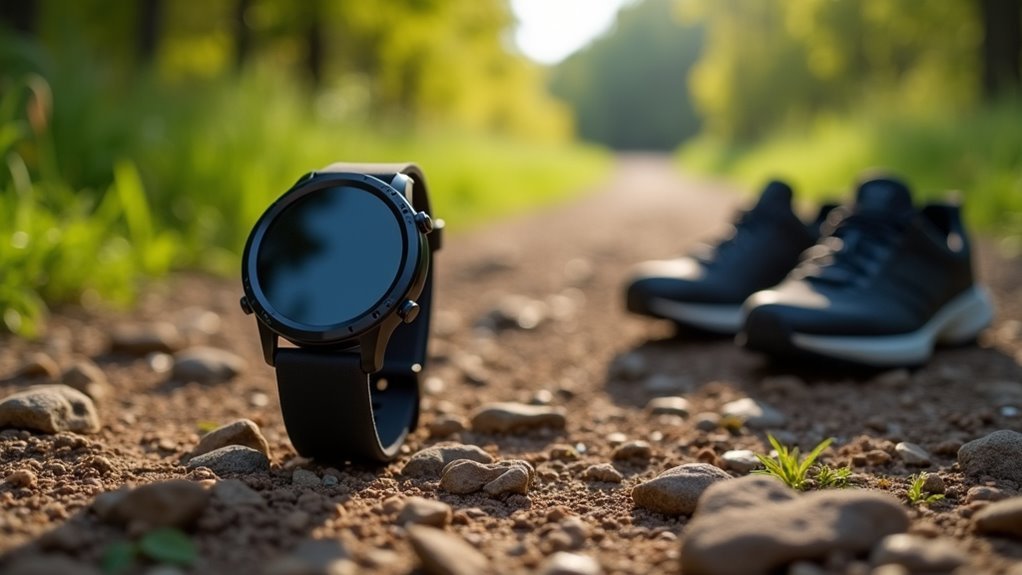
Since LTE running watches operate independently from your smartphone, their GPS accuracy becomes absolutely critical for reliable distance tracking and route navigation.
Most standalone models incorporate multi-band GNSS chipsets that support multiple satellite systems for enhanced coverage.
You’ll find GPS accuracy typically ranges within 1-3% error margin under ideal conditions.
However, performance varies considerably in challenging environments:
- Dense canopy and urban canyons degrade satellite signals through multipath interference
- Dual-frequency GPS (L1 + L5 bands) mitigates atmospheric disturbances for superior accuracy
- Barometric altimeters combined with GNSS improve elevation data reliability on mountainous routes
- Assisted GPS (A-GPS) preloads satellite data for faster signal acquisition
- Sensor fusion with accelerometers and gyroscopes maintains tracking during signal loss
Top-performing models from Garmin consistently achieve accuracy ratings of 9.5 across various testing conditions. Calibrated footpods paired with GPS watches often deliver better pace accuracy than GPS alone.
Music Streaming and Storage Options for LTE Running Watches
Music transforms your running experience, and LTE watches deliver unprecedented freedom by eliminating the need to carry your phone while maintaining access to your favorite tracks.
You’ll find robust streaming support through Spotify, Amazon Music, YouTube Music, and Deezer, all requiring premium subscriptions for offline syncing capabilities.
Storage capacity varies greatly between models. The Samsung Galaxy Watch 7 offers 32GB storage, while the Garmin Forerunner 945 LTE holds up to 1,000 songs and the Fenix 6 Pro stores 2,000 songs. You can load MP3 files directly or download playlists via LTE connectivity.
Offline playback conserves battery life compared to streaming, and you’ll appreciate intuitive music controls during runs.
Voice assistant integration provides hands-free operation, while playlist management keeps your music organized. Advanced models like the Feni 8 include speaker playback functionality, allowing music without requiring Bluetooth headphones.
Safety Features and Emergency Communication Capabilities
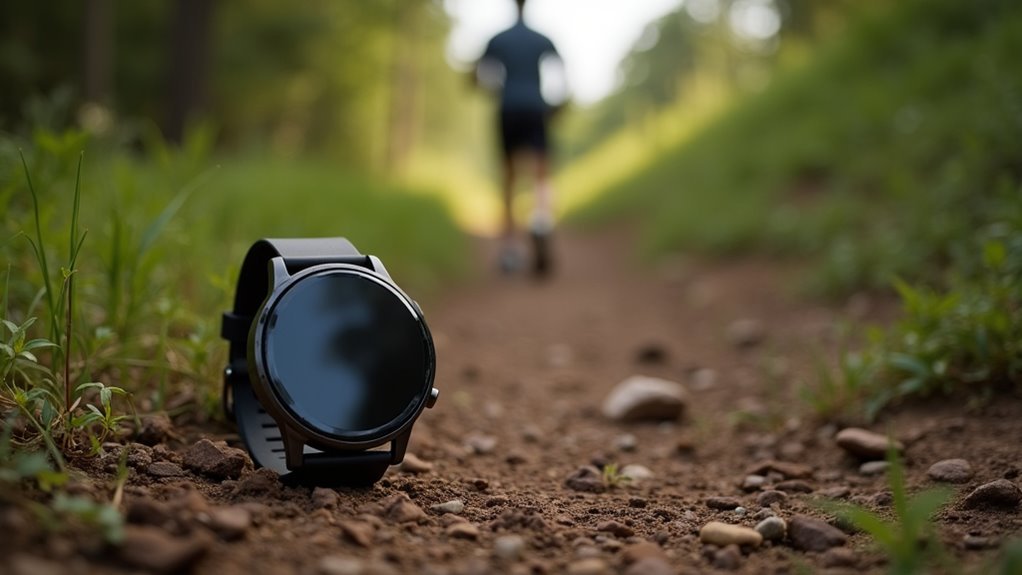
When you’re running alone on remote trails or through unfamiliar neighborhoods, LTE watches serve as your digital guardian, providing essential safety features that can mean the difference between a minor incident and a serious emergency.
These watches detect sudden impacts or decelerations during your run, automatically triggering emergency protocols. You’ll get sophisticated incident detection through advanced sensors and algorithms that monitor your movements for unusual patterns.
Key safety capabilities include:
- Automated emergency calls to emergency services without your phone
- Real-time location sharing with pre-set emergency contacts via GPS
- SOS messaging with customizable emergency messages
- Impact sensing that detects falls or accidents during activities
- LiveTrack functionality for continuous location monitoring during runs
Some models even integrate with satellite devices for coverage beyond cellular networks. Most devices provide up to 10 seconds to cancel an emergency request if the incident detection feature triggers accidentally during your run.
Durability Testing: Water Resistance and Impact Protection
Beyond keeping you connected during emergencies, your LTE running watch must withstand the physical demands of regular training sessions, unpredictable weather, and the occasional accident. Modern LTE watches undergo rigorous durability testing to guarantee they’ll survive your toughest workouts.
| Watch Model | Water Resistance | Impact Protection |
|---|---|---|
| Apple Watch Ultra | 100m (ISO 22810) | Titanium construction |
| Samsung Galaxy Watch Ultra | 10 ATM + IP68 | Reinforced materials |
| Garmin Forerunner Series | 50m rating | Drop testing certified |
| Polar GPS Watches | 5 ATM rating | Shock-absorbing design |
| Premium Models | Advanced seals | Scratch-resistant glass |
You’ll find that top-tier models feature titanium or stainless steel construction, advanced seal systems, and nano-coatings for enhanced protection. Professional reviewers spend weeks to months testing these devices under real-world conditions to ensure they meet manufacturer durability claims. Remember to clean your watch after water exposure and regularly inspect for impact damage signs.
App Ecosystem and Third-Party Integration Support
You’ll want an LTE smartwatch that seamlessly integrates with your favorite running apps like Strava, Nike Run Club, and Garmin Connect to track your progress and share achievements.
Your music experience matters too, so look for watches that support Spotify, Apple Music, or other streaming services you already use.
The best running watches also sync effortlessly with major health platforms like Apple Health, Google Fit, and Samsung Health to give you a complete picture of your fitness data. Consider prioritizing watches with built-in features rather than relying heavily on third-party apps for core functionality, as this typically provides a more reliable and integrated experience during your runs.
Popular Running Apps
The app ecosystem surrounding LTE running watches has expanded dramatically, offering runners access to thorough training platforms that extend far beyond basic activity tracking.
You’ll find comprehensive solutions that work seamlessly across devices, giving you freedom to run phone-free while maintaining full functionality.
Popular running apps available on LTE watches include:
- Strava – Real-time recording with social features and segment challenges
- Map My Run – Supports 600+ activities with 60M+ user community
- Runkeeper – Personalized training plans with multi-platform compatibility
- Nike Run Club – Audio-guided runs with coaching features
- Adidas Running – Goal-based training with progress analytics
These apps sync automatically when you’re back in range, ensuring your data transfers seamlessly between your watch, phone, and desktop platforms without missing any workout details. Many of these platforms also incorporate Strava Beacon functionality for live location sharing, providing an essential safety feature for solo runners venturing out without their phones.
Music Streaming Services
While running apps handle your fitness tracking, music streaming services transform your LTE watch into a complete entertainment hub that keeps you motivated throughout your workouts.
You’ll find robust support for major platforms like Spotify, Amazon Music, YouTube Music, and Deezer on most LTE smartwatches, especially Wear OS devices.
Premium subscribers can sync offline playlists directly to their watch, eliminating phone dependency during runs. The Samsung Galaxy Watch 7’s 32GB storage accommodates extensive music libraries, while the Google Pixel Watch 2 stores up to 2,000 songs locally.
You’ll appreciate direct playlist management from your wrist and seamless cross-platform compatibility.
LTE connectivity enables high-quality streaming without your phone nearby, though it’ll impact battery life and requires a separate data plan. The Google Pixel Watch 3 offers ample storage for music streaming with its regularly updated features via Pixel Drops.
Health Platform Compatibility
Beyond entertainment features, LTE watches excel when they seamlessly integrate with your existing health ecosystem, creating a unified fitness experience across all your devices.
Your running data automatically syncs with major platforms, ensuring you’ll never lose track of your progress. Most LTE watches support cross-platform compatibility, working with both iOS and Android devices while maintaining essential features.
Key integration capabilities include:
- Popular health apps like Strava, Apple Health, and Google Fit for extensive tracking
- Running-specific apps including Runkeeper and Runtastic for detailed performance analysis
- Nutrition tracking through MyFitnessPal integration for complete wellness monitoring
- Cloud syncing via Google Drive or iCloud for seamless data backup
- Customizable dashboards that focus on your specific running goals and metrics
This connectivity transforms your watch into a central hub for all fitness activities. However, be aware that enabling LTE functionality will require daily charging as the cellular connection significantly drains battery life compared to standard smartwatch usage.
Cost Analysis: Premium Vs Budget LTE Running Watch Options
When choosing an LTE running watch, you’ll face a significant price divide between premium and budget options that extends far beyond the initial purchase price.
Premium models like the Apple Watch and Garmin Forerunner 945 offer superior GPS accuracy, AMOLED displays, and extensive app integration, but they’ll cost you more upfront and typically require pricier monthly data plans.
Premium LTE watches deliver exceptional performance and features, but expect higher upfront costs and more expensive monthly data subscriptions.
Budget options like the Samsung Galaxy Watch FE still provide essential features including GPS tracking and heart rate monitoring at more accessible prices.
However, you’ll sacrifice some accuracy, display quality, and app support. Consider your current training level and frequency of running sessions when evaluating battery life requirements for different LTE watch models.
Both categories require ongoing LTE subscription costs, so factor monthly fees into your total ownership expenses when making your decision.
Setup and Carrier Compatibility for Cellular Watch Plans
After selecting your ideal LTE running watch within your budget, you’ll need to navigate the setup process and guarantee your carrier supports cellular connectivity for your specific device.
The activation process varies by manufacturer and carrier. Apple Watch users should open the Apple Watch app, tap “My Watch” and “Cellular,” then follow carrier instructions.
Samsung Galaxy Watch requires the Galaxy Wearable app with a SIM card inserted in your phone. Google Pixel Watch users must locate the EID in Connectivity settings.
Key setup considerations include:
- Carrier compatibility – Verify your carrier supports your watch model
- Plan sharing – Some watches share your phone’s number, others need separate lines
- QR code requirements – Many carriers require activation codes
- eSIM technology – Enables activation without physical SIM cards
- Direct activation – Newer watches allow setup without phone connection
Before beginning the setup process, ensure you have the latest software installed on both your smartphone and smartwatch to avoid compatibility issues during activation.
Real-World Performance Testing Results and User Reviews
While specifications tell part of the story, real-world testing reveals how LTE running watches actually perform when you’re pounding the pavement. GPS accuracy consistently impresses, with top models like the Huawei WATCH GT Runner delivering sub-3% error rates for distances from 5K to half-marathons.
You’ll find that dual-frequency GPS isn’t essential for reliable performance, as proven by watches like the Garmin Forerunner 165.
However, LTE connectivity presents trade-offs you should consider. While you’ll enjoy phone-free running with features like emergency SOS and music streaming, expect reduced battery life and variable coverage affecting performance. Firmware updates can significantly impact tracking accuracy, with users reporting improved distance measurements after installing newer versions.
Users report mixed satisfaction with LTE functionality—some love the freedom, while others question the necessity. Heart rate monitoring proves reliable though less accurate than chest straps. Firmware updates play a crucial role in optimizing watch performance over time.
Frequently Asked Questions
Can I Use My Existing Phone Number on an LTE Watch?
Yes, you can use your existing phone number on an LTE watch through number sharing. You’ll need a compatible carrier like Verizon, AT&T, or T-Mobile, plus an eligible smartphone to pair with your watch.
Do LTE Watches Work Internationally While Traveling and Running Abroad?
Yes, you can use LTE watches internationally, but it depends on your carrier’s roaming agreements and your watch’s compatibility. Check with your carrier about international data plans and costs before traveling abroad.
How Much Does Cellular Data Usage Cost for LTE Watches Monthly?
You’ll pay $10-15 monthly for LTE watch cellular data. Most carriers charge around $10-12 base price, plus $3-4 in taxes and fees. There’s often a one-time $35 activation fee too.
Will My LTE Watch Receive All Text Messages and Calls?
Your LTE watch will receive all calls and most text messages independently. However, some third-party messaging apps might not be fully supported depending on your watch’s platform and compatibility settings.
Can I Switch Between Different Carriers With the Same LTE Watch?
You can switch carriers with your LTE watch if it uses eSIM technology. However, not all carriers support watch eSIMs, and compatibility varies by region and specific watch model.

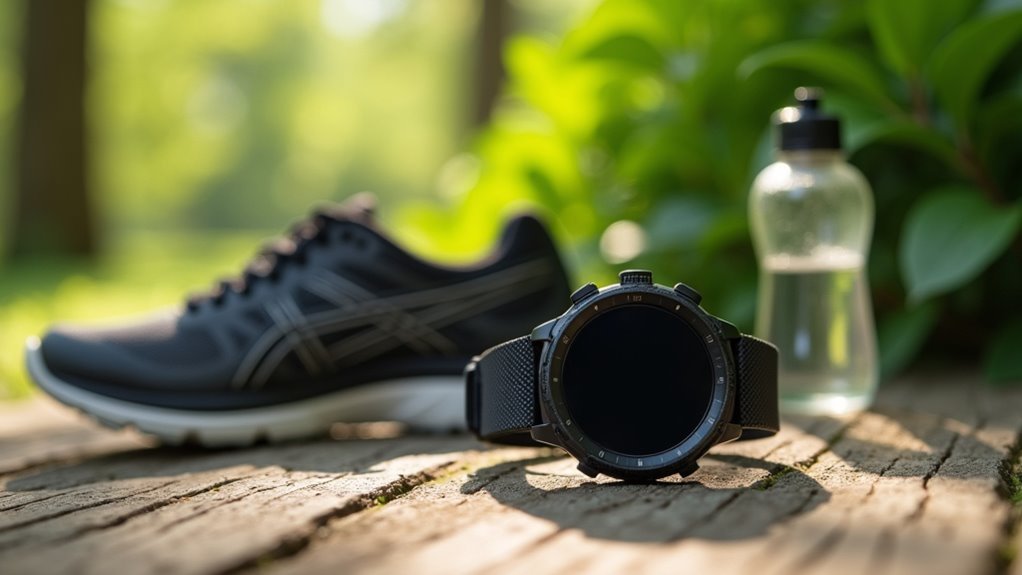

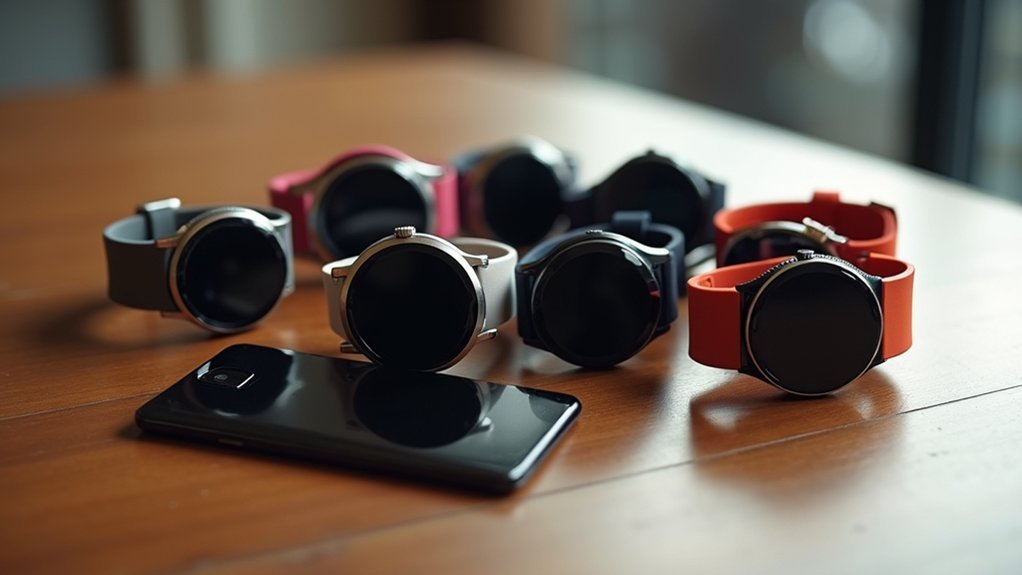
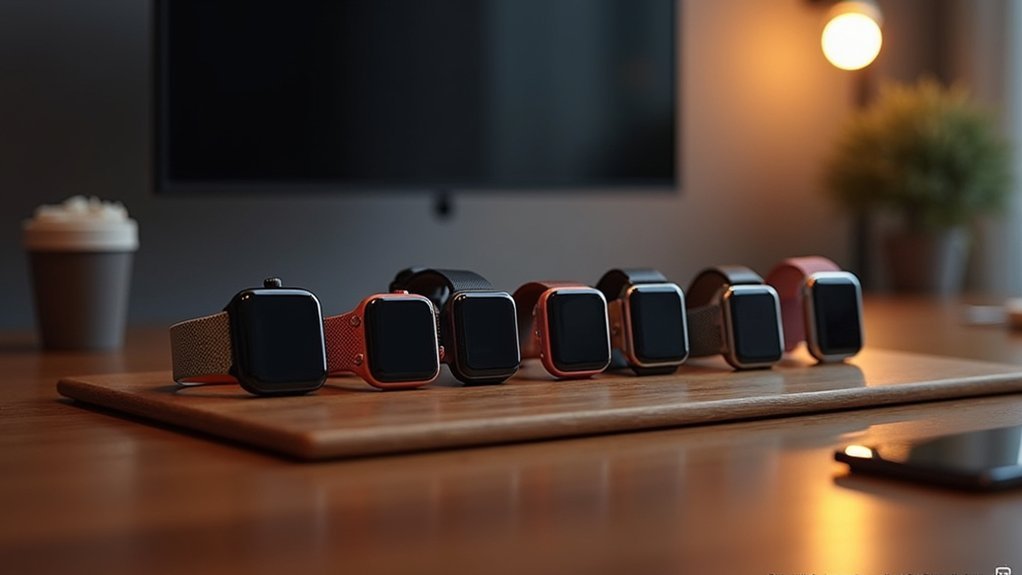
Leave a Reply